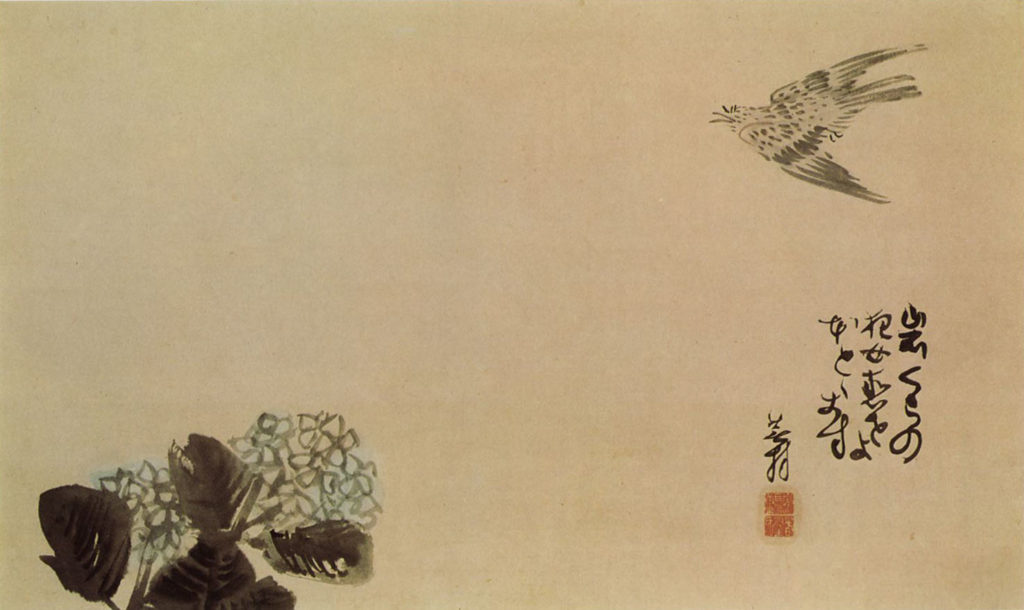
Japan’s Haiku is part of a wealth of great and rich Asian cultural treasures. We are heirs of that culture but have not fully exploited its heritage as it deserves. Many of its achievements and quintessence are waiting for us.
Haiku incorporates and crystallizes many values in the deeply penetrated cultures of the East from India to Japan. So we see in this small form of poetry this little spirit of Buddhism, the Zen breath that we still find in our poetry of Tran Ly. In addition, Haiku also has the scent of ikebana flower arrangement and chanoyu tea ceremony atmosphere developed from the fourteenth century with the basic spirit of being true, harmonious and pure. Haiku seemed to hide in it the gloom of the Noh drama.
Traditional Japanese poetry is often based on verses 5-7. Based on this basic rhythm, the form of poetry (ren-ga) appeared in the late Middle Ages. This style of poetry is like our recitation. People prepare to renga when visiting a temple, in the moon watching party, while drinking sake and resting, between two fights.
To make poems, there are usually several people attending. They alternately compose the verses. Just one paragraph three sentences, one paragraph two sentences. The topic is preceded by a passage, such as spring or winter, as a journey, poverty, love … Such as:
Drops of sadness
And it hurts so much
The flower stays behind me
(Soda)
In the fog of darkness
The last ray of sunlight shimmered
(Shohhaka)
Of these rengas the opening is the most important and is called Hokku. Hokku gradually became independent, forming a separate form of poetry, changing its name to Haiku (Haiku).
The whole Haiku has only three sentences, consisting of 17 syllables (5-7-5). Japanese is polyphonic so the whole song doesn’t have many words. For example, cuckoo in Japanese called hototogisu has occupied the five syllables of the song, possibly becoming a verse of its own.
Hototogisu
Naki naki tobu zo
Isogawashi
Oh the cuckoo wings
Jubilant fly and sing
Busy how tight!
(Basho)
And even in this independent form, the connection between the two poets for sympathy remains. This property can be illustrated by the story of the famous eighteenth-century poet, Chiyô. She lived alone in the recollection of her deceased husband and child, so a friend compared her to the lonely willow tree:
There are no flowers on her
Life is silent
Green willow tree
Chiy accepted the poem, changing only one row:
There are no flowers on her
Body no longer implications
Green willow tree
This nature also says this: Haiku requires readers to read poetry as if they are silently chatting with the poet, as if the same creative poet continued. Thought it was the attitude needed to enter the very delicate world of Haiku. With this attitude, the reader will be less surprised when first meeting with Haiku, one of the famous concise poetry in the world.
Haiku’s first characteristic is condensation. East Asian poetry is generally condensed. The brief form of Haiku, tanka, quartet, Vietnamese folk songs … has a very significant capacity for human affection. These are very tight fists, so they have great strength. Haiku represents that condensed style, commenting on words. Haiku always knows how to be empty, which means creating a vacuum in poetry. This vacuum can be said to be very necessary. In a simple picture, how to draw the sound of the wind blowing? Yet a good artist must do that. They only draw branches but we can hear the sound of the wind blowing.
Come and see! To see
Only one lonely leaf
On the kiri
(Basho)
Basho, the master of Haiku, did not draw the sound of the wind, but the reader felt nervous and fearful for the last leaf.
Based on this feature, Tagor makes a very accurate comment about Haiku: “The poet only introduces the topic, then steps aside” (1).
Here, we see the poet Haiku (Haijin) has great respect for the reader. On the way of poetry, the Haijin gave way to the readers, not encroaching nor blocking the way. The reader goes with the poet and still goes on when the poet stops. But like that, the reader has no passive right. The poet does not tell me everything. The conversation was exhausted without being bored. Talking with poetry is even more impossible for the boredom to rise up.
Tagor further explained: “The reason the poet withdrew so quickly was because the Japanese reader had a great mental power of imagination.” (2)
The comment of the Indian poet may discourage non-Japanese readers. Actually, that ability is not the privilege of Japanese readers. Anyone who loves poetry can read Haiku, and after a while of studying can feel Haiku like many other poems. Moreover, poetry is not just about the people alone. “The transmitter” is Japanese but the “recipient” can be from any ethnic group. A good poem must have the power to signal the beauty.